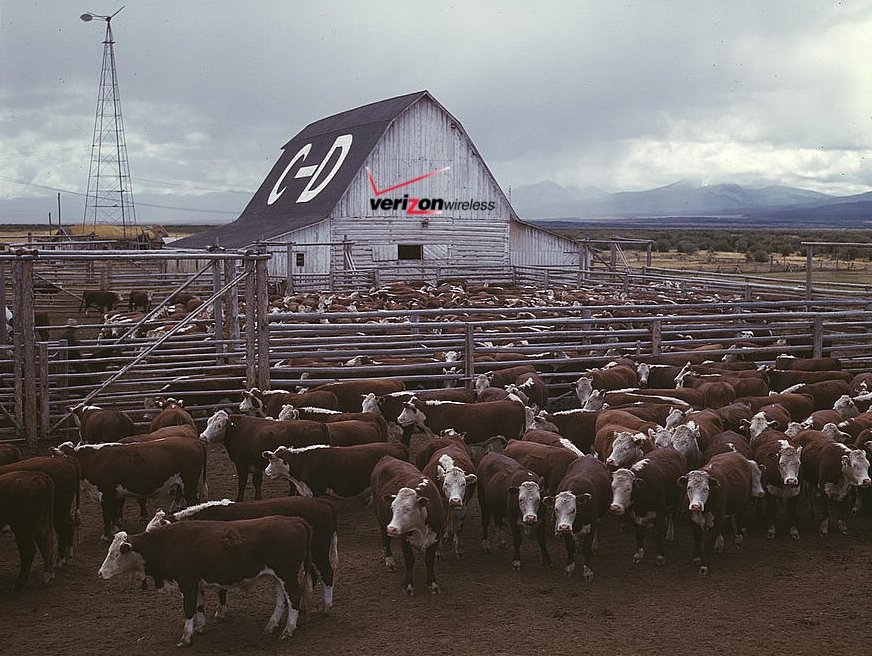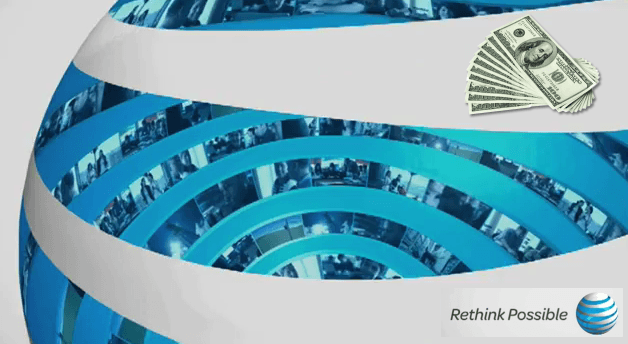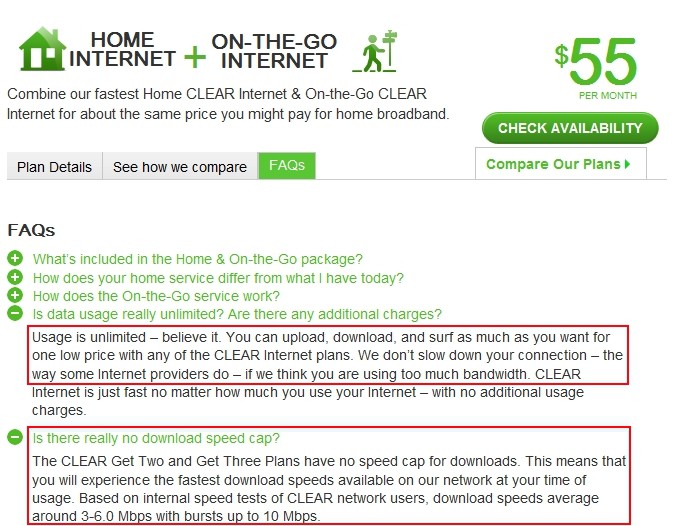
Verizon hopes to herd its smartphone owners onto limited use data plans on its new LTE high speed network
Verizon this week unveiled a list of 38 major cities where the company’s much-faster LTE wireless broadband service will launch by year’s end. Dubbed by some as the “list of cities with NFL franchises,” Verizon’s choices delighted some, but puzzled others.
But before the celebrations get out of hand, incoming Verizon CEO Lowell McAdam warned customers need to prepare themselves, and their wallets, for major price changes.
Specifically, the company intends to treat its new 4G network, with top speeds of 5-12Mbps downstream and 2-5Mbps upstream, as a premium product with a premium price. It comes complete with a classic Internet Overcharging scheme.
“We think there’s a place for unlimited plans,” McAdam announced, “but we think that over time, because we have finite resources, our customers are going to have to shift to a pay-as-you-use model. I would say that clearly over time we will be migrating to a bucket-of-megabytes” price schedule.
Verizon’s finite resources are more infinite than those of its customers, however.
Much like its partner-in-pricing – AT&T, Verizon is preparing to ditch its unlimited data plan for smartphone customers. Despite the fact its new LTE network will offer a more efficient network experience for both Verizon and its customers, the nation’s largest wireless carrier wants limits on how much data customers can exchange over their new network, with overlimit fees for those who use too much.
Exact pricing has yet to be announced.
Amidst the flurry of excitement over McAdam’s appearance at the San Francisco wireless industry conference, yet more rumors of the forthcoming arrival of a Verizon iPhone also made headlines. Apple is reportedly releasing a CDMA version of its popular phone soon, and despite the fact there are other CDMA networks in the world, reporters presumed it must be intended for the American market.
After the press conference, the list of cities to get Verizon’s new LTE network became a hot topic for debate. In western New York, only Rochester made the cut. For residents in Buffalo, who would like to remind Verizon they have an NFL team, the slight did not go unnoticed. It made news on the city’s most watched nightly local newscast.
But those of us in Rochester remind our friends in the Queen City they have Verizon FiOS while we are stuck in a broadband backwater with Frontier Communications. (Besides, the Buffalo Bills training camp is in Rochester.) The broadband gap between the two cities could have made Rochester a ripe target for Verizon, assuming customers can afford the price of the service plan.
Folks in Austin noted they are not on Verizon’s list either, despite the Texas city’s high-tech-embracing reputation. Houston, the Dallas-Ft. Worth Metroplex, and San Antonio did make the list. But fear not Austin, you will be able to use LTE at the Austin-Bergstrom International Airport.
For existing Verizon customers in the chosen places, the imminent arrival of 4G may stall customers from upgrading phones until new LTE-capable models arrive in time for the holidays. But the Data Grinch That Stole Flat Rate Wireless may still be confounded by the number of customers who let their contracts expire and stick with their existing phones, refusing to expose themselves to mandatory, overpriced data plans.
Verizon Wireless 4G LTE Initial Major Metropolitan Area Deployment
Akron, Ohio
Athens, Georgia
Atlanta, Georgia
Baltimore, Maryland
Boston, Massachusetts
Charlotte, North Carolina
Chicago, Illinois
Cincinnati, Ohio
Cleveland, Ohio
Columbus, Ohio
Dallas-Fort Worth Metroplex, Dallas, Texas
Denver, Colorado
Fort Lauderdale, Florida
Houston, Texas
Jacksonville, Florida
Las Vegas, Nevada
Los Angeles, California
Miami, Florida
Minneapolis/Saint Paul, Minnesota
Nashville, Tennessee
New Orleans, Louisiana
New York, New York
Oakland, California
Oklahoma City, Oklahoma
Orlando, Florida
Philadelphia, Pennsylvania
Phoenix, Arizona
Pittsburgh, Pennsylvania
Rochester, New York
San Antonio, Texas
San Diego, California
San Francisco, California
San Jose, California
Seattle/Tacoma, Washington
St. Louis, Missouri
Tampa, Florida
Washington, D.C.
West Lafayette, Indiana
West Palm Beach, Florida
Verizon Wireless 4G LTE Initial Commercial Airport Deployment (Airport Name, City, State)
Austin-Bergstrom International, Austin, Texas
Baltimore/Washington International Thurgood Marshal, Glen Burnie, Maryland
Bob Hope, Burbank, California
Boeing Field/King County International, Seattle, Washington
Charlotte/Douglas International, Charlotte, North Carolina
Chicago Midway International, Chicago, Illinois
Chicago O’Hare International, Chicago, Illinois
Cincinnati/Northern Kentucky International, Covington, Kentucky
Cleveland-Hopkins International, Cleveland, Ohio
Dallas Love Field, Dallas, Texas
Dallas/Fort Worth International, Fort Worth, Texas
Denver International, Denver, Colorado
Fort Lauderdale/Hollywood International, Fort Lauderdale, Florida
George Bush Intercontinental/Houston, Houston, Texas
Greater Rochester International, Rochester, New York
Hartsfield-Jackson Atlanta International, Atlanta, Georgia
Honolulu International, Honolulu, Hawaii
Jacksonville International, Jacksonville, Florida
John F. Kennedy International, New York, New York
John Wayne Airport-Orange County, Santa Ana, California
Kansas City International, Kansas City, Missouri
La Guardia, New York, New York
Lambert-St. Louis International, St. Louis, Missouri
Laurence G. Hanscom Field, Bedford, Massachusetts
Long Beach/Daugherty Field, Long Beach, California
Los Angeles International, Los Angeles, California
Louis Armstrong New Orleans International, Metairie, Louisiana
McCarran International, Las Vegas, Nevada
Memphis International, Memphis, Tennessee
Metropolitan Oakland International, Oakland, California
Miami International, Miami, Florida
Minneapolis-St. Paul International/Wold-Chamberlain, Minneapolis, Minnesota
Nashville International, Nashville, Tennessee
New Castle, Wilmington, Delaware
Newark Liberty International, Newark, New Jersey
Norman Y. Mineta San Jose International, San Jose, California
North Las Vegas, Las Vegas, Nevada
Orlando International, Orlando, Florida
Orlando Sanford International, Sanford, Florida
Palm Beach International, West Palm Beach, Florida
Philadelphia International, Philadelphia, Pennsylvania
Phoenix Sky Harbor International, Phoenix, Arizona
Phoenix-Mesa Gateway, Mesa, Arizona
Pittsburgh International, Pittsburgh, Pennsylvania
Port Columbus International, Columbus, Ohio
Portland International, Portland, Oregon
Rickenbacker International, Columbus, Ohio
Ronald Reagan Washington National, Arlington, Virginia
Sacramento International, Sacramento, California
Salt Lake City International, Salt Lake City, Utah
San Antonio International, San Antonio, Texas
San Diego International, San Diego, California
San Francisco International, San Francisco, California
Seattle-Tacoma International, Seattle, Washington
St. Augustine, Saint Augustine, Florida
St. Petersburg-Clearwater International, Clearwater, Florida
Tampa International, Tampa, Florida
Teterboro, Teterboro, New Jersey
Trenton Mercer, Trenton, New Jersey
Washington Dulles International, Dulles International Airport, Washington, D.C.
Will Rogers World, Oklahoma City, Oklahoma
William P. Hobby, Houston, Texas
[flv width=”640″ height=”500″]http://www.phillipdampier.com/video/Verizon Wireless LTE Announced 10-7-10.flv[/flv]
Verizon Wireless’ announced LTE network was a common topic on local newscasts in several cities. We include WIVB-TV in Buffalo, noting that city didn’t make the cut, WCVB-TV in Boston which spent plenty of time on the resurgence of the rumored Verizon iPhone, WLFI-TV in West Lafayette, Indiana which discussed the network’s implications for Purdue University students, and a promotional video from Verizon itself interviewing visitors to a Boston pizzeria gushing over the speed of Verizon’s newest technology. (5 minutes)


 Subscribe
Subscribe








